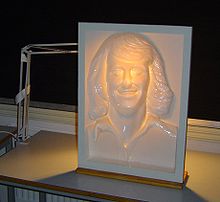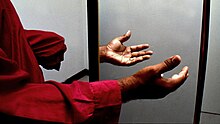User:Sammy Tavassoli/sandbox
Note: While this section will be added to the existing article, Optical Illusion, all content here is original, and none of the existing content was copied here. I am only focusing on adding/improving this section of the article, but I would like to add the following sentence to the end of the lead:
Optical illusions, as well as multi-sensory illusions involving visual perception, can also be used in the monitoring and rehabilitation of some psychological disorders, including phantom limb syndrome[1] and schizophrenia.[2]
Perception in psychological disorders
[edit]Illusions and schizophrenia
[edit]
Schizophrenia, a mental disorder often marked by hallucinations, has been shown to decrease a person's ability to perceive high-order optical illusions.[2] The disorder impairs one's capacity to perform top-down processing and higher-level integration of visual information beyond the primary visual cortex, V1.[2] Understanding how this specifically occurs in the brain may help in understanding how visual distortions, beyond purely imaginary hallucinations, affect schizophrenic patients.[2] Additionally, researchers hope to better identify where specific illusions are processed in the visual streams by evaluating the differences between how schizophrenic patients and normal individuals see optical illusions.[2]


One study on schizophrenic patients found that they were extremely unlikely to be fooled by a three dimensional optical illusion, the hollow face illusion, unlike neurotypical volunteers.[3] Based on fMRI data, researchers concluded that this resulted from a disconnect between their systems for bottom-up processing of visual cues and top-down interpretations of those cues in the parietal cortex.[3] In another study on the motion-induced blindness (MIB) illusion, schizophrenic patients continued to perceive stationary visual targets even when observing distracting motion stimuli, unlike neurotypical controls, who experienced motion induced blindness.[4] The schizophrenic test subjects demonstrated impaired cognitive organization, meaning they were less able to coordinate their processing of motion cues and stationary image cues.[4]
The rubber hand illusion (RHI)
[edit]
The rubber hand illusion (RHI), a multi-sensory illusion involving both visual perception and touch, has been used to study how phantom limb syndrome affects amputees over time.[1] Amputees with the syndrome responded to the illusion, which involved observing a rubber hand being touched or stroked in place of a real hand, more strongly than non-amputee controls.[1] However, in some studies, amputees actually had stronger responses to RHI on their intact arm, and more recent amputees responded to seeing the illusion more than amputees who had been missing an arm for years or more.[1] This was hypothesized to be a sign that the body schema, or an individual's sense of their own body and its parts, progressively adapts to the post-amputation state.[1] Essentially, the amputees were learning to no longer respond to sensations near what had once been their arm.[1] As a result, some have suggested the use of RHI as a tool for monitoring an amputee's progress in reducing their phantom limb sensations and adjusting to the new state of their body.[1]
Other research used RHI in the rehabilitation of amputees who felt psychologically dissociated from prosthetic limbs.[5] After prolonged exposure to RHI, the amputees gradually adjusted to daily life with their prosthetic (which resembled the rubber hand) and the rest of their body.[5] This was thought to be because they adapted to responding to and moving a limb that did not feel as connected to the rest of their body or senses.[5] RHI may also be used to diagnose certain disorders related to impaired proprioception or impaired sense of touch in non-amputees.[5]
Recommended section deletion
[edit]The section on the "Cognitive processes hypothesis" was almost entirely (directly) copied from this website: https://www.opticalspy.com/spy-blog/cognitive-processes-hypothesis. The information on Wikipedia was first published in 2015, while the website it was taken from (which does not seem at all reliable) was published in 2013. Thus, I suggest deleting it. The specific "hypothesis" mentioned also does not seem to appear in any readily available academic sources, and much of the information is uncited, excluding a few sentences I (prematurely) added myself.
References
[edit]- ^ a b c d e f g DeCastro, Thiago Gomes; Gomes, William Barbosa (2017-05-25). "Rubber Hand Illusion: Evidence for a multisensory integration of proprioception". Avances en Psicología Latinoamericana. 35 (2): 219. doi:10.12804/revistas.urosario.edu.co/apl/a.3430. ISSN 2145-4515.
- ^ a b c d e King, Daniel J.; Hodgekins, Joanne; Chouinard, Philippe A.; Chouinard, Virginie-Anne; Sperandio, Irene (2017-06-01). "A review of abnormalities in the perception of visual illusions in schizophrenia". Psychonomic Bulletin & Review. 24 (3): 734–751. doi:10.3758/s13423-016-1168-5. ISSN 1531-5320.
- ^ a b Dima, Danai; Roiser, Jonathan P.; Dietrich, Detlef E.; Bonnemann, Catharina; Lanfermann, Heinrich; Emrich, Hinderk M.; Dillo, Wolfgang (2009-07-15). "Understanding why patients with schizophrenia do not perceive the hollow-mask illusion using dynamic causal modelling". NeuroImage. 46 (4): 1180–1186. doi:10.1016/j.neuroimage.2009.03.033. ISSN 1053-8119.
- ^ a b Tschacher, Wolfgang; Schuler, Daniela; Junghan, Ulrich (2006-01-31). "Reduced perception of the motion-induced blindness illusion in schizophrenia". Schizophrenia Research. 81 (2): 261–267. doi:10.1016/j.schres.2005.08.012. ISSN 0920-9964.
- ^ a b c d Christ, Oliver; Reiner, Miriam (2014-07-01). "Perspectives and possible applications of the rubber hand and virtual hand illusion in non-invasive rehabilitation: Technological improvements and their consequences". Neuroscience & Biobehavioral Reviews. Applied Neuroscience: Models, methods, theories, reviews. A Society of Applied Neuroscience (SAN) special issue. 44: 33–44. doi:10.1016/j.neubiorev.2014.02.013. ISSN 0149-7634
 | This is a user sandbox of Sammy Tavassoli. You can use it for testing or practicing edits. This is not the sandbox where you should draft your assigned article for a dashboard.wikiedu.org course. To find the right sandbox for your assignment, visit your Dashboard course page and follow the Sandbox Draft link for your assigned article in the My Articles section. |
